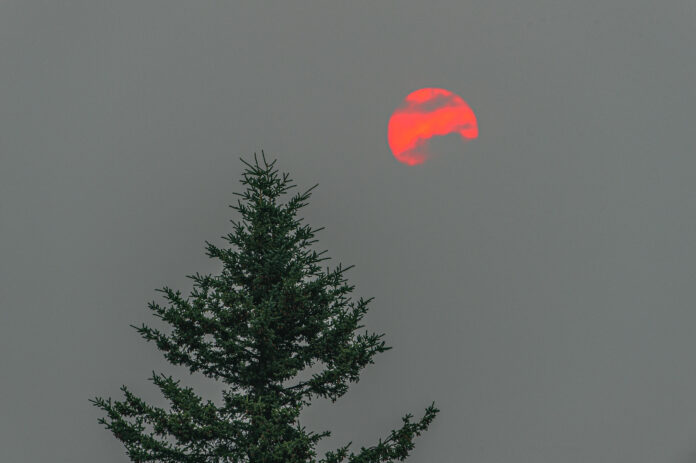
Wildfires burning across Alaska’s Interior are creating widespread air quality concerns, particularly in and around Fairbanks, where smoke from multiple fires has led to elevated pollution levels and reduced visibility.
As of 6:45 pm Monday, the Air Quality Index in Fairbanks ranged between 124 and 136 — a level categorized as Unhealthy for Sensitive Groups. The primary pollutant is fine particulate matter (PM2.5), smoke essentially, which can aggravate respiratory conditions. However, air quality gradually improved throughout the day and is expected to reach Moderate levels by Tuesday, though smoke remains present.
The smoke is primarily driven by increased fire activity. Bear Creek Fire in the Denali Borough has grown to 21,000 acres. Northeast of Delta Junction, the Twelvemile Lake Fire (#220) has grown significantly, and is now estimated at approximately 13,907 acres. The fires have prompted a robust response by the Alaska Division of Forestry, which is also actively engaged in two other area fires: the Lake George Fire (#224), at an estimated 200 acres, and the Sand Lake Fire (#292), at roughly 2,856 acres.
Fire crews are prioritizing point protection for multiple threatened cabins in the Twelvemile Lake Fire. Pumps and sprinkler systems are being deployed around structures, with both ground and aerial teams supported by boating operations. This logistical effort is resulting in increased traffic on local waterways and roadways, especially around Twelvemile Lake, Healy Lake, Sand Lake, and Lake George. Travelers in these areas are advised to use caution and remain alert to rapidly changing conditions.
Although Monday’s weather has brought some relief, including cooler temperatures and potential precipitation, fuels across the region remain critically dry. The number of new fire starts dropped to 9 on Sunday, a significant decrease from more than 30 starts detected on Saturday. Still, approximately 184 fires remain active across the state.
Elsewhere in the Interior, smoke conditions vary. Tok continues to experience Unhealthy air quality with visibility limited to 1–5 miles. Fort Yukon and Bettles are seeing mostly Moderate conditions, with intermittent periods of AQI levels deemed Unhealthy for Sensitive Groups. In contrast, Galena and McGrath are currently experiencing Good air quality with minimal smoke impacts.
Overall, heavy smoke is expected to lift slowly in most areas, though periodic haze and visibility challenges will persist. Visibility in most affected zones should improve to between 6 and 10 miles, though localized conditions will vary.
Residents are being encouraged to monitor air quality reports and wildfire updates regularly and to take precautions, particularly if they belong to sensitive health groups. While improved weather may aid suppression efforts in the days ahead, fire and smoke activity remain dynamic.
Thanks to all of the smokejumpers, equipment operators, pilots, ground crews, and everyone else who is helping the Interior. You are our heroes.
10 beautiful days of 80+° in Fairbanks, but no rain, usually results in wildfires and smoke. Hopefully, the skies will pour beautiful rain this week and next
In any report on wildfires, I always find myself wishing that maps of their exact locations would be included. It is frustratingly vague to try to place them otherwise.
Those maps are available in real time online. Just Google Alaska wildfire. Pull up the map and click on the fire you are interested in. You will get the latest info. The one from the University of Alaska seems most helpful to me.
The FNSB Air Quality (Control freaks) must feel terrible about this. Since there is really no one they can blame, much less hand out citations and fines to! The Weather Man? The firefighters? Lol!